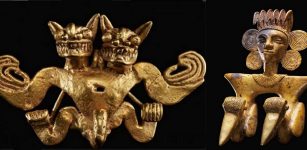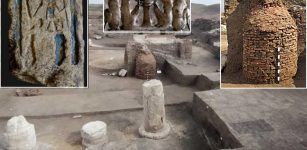Advanced Ancient Knowledge Of Chemistry – From Chrome Plating To Nanotubes
AncientPages.com - The ancient Babylonians were the first to use sophisticated geometry – a staggering 1,400 years before it was previously thought to have been developed. Sadly, these mathematical innovations were forgotten as the Babylonian civilisation collapsed and were only rediscovered this year as scientists took a close look at ancient clay tablets.
The Pantheon dome - made entirely out of concrete. MatthiasKabel/wikimedia, CC BY-SA
This surprising finding made me wonder about what other scientific methods that we put down to modern minds were actually discovered by ancient civilisations. So I decided to hunt down some of the most advanced uses of chemistry.
Qin Dynasty chrome plating
The mirrored shine of chrome-plated metal is almost a symbol of the modern era. A thin chrome layer coats metals and plastics in kitchens, bathrooms and cars. Credit for chrome-plating technology goes to George Sargent who published a method in 1920 that lead to the commercial plating that dominated the Art Deco period and beyond. In fact, other famous chemists including Robert Bunsen dabbled with chrome plating in the mid-19th century. But all of these may have been beaten to the shine by the metallurgists of the Qin dynasty in China some 2,000 years before chrome had even been identified in the West.
Qin dynasty sword on display. Mark Lorch/Flickr, CC BY-ND
In the 1970s, razor sharp swords coated in a thin layer of chromium oxide were unearthed along with the the famous Terracotta army. The Chinese suggest that their 1st dynasty weapon smiths coated officers’ weapons to protect them from corrosion. And indeed, two millennia later the blades are untarnished. However, whether this is really the case or in fact the chromium layer slowly formed from a peculiarity of the blade’s composition and the fires that ravaged the buried terracotta army is a matter of debate.
Roman concrete
Concrete is the mainstay of modern buildings, but ancient civilisations also used it to great effect. Concrete is a composite, meaning that it is made from two or more materials; cement is mixed with sand and gravel, which then sets into whatever structure is required. The most famous ancient concrete buildings are probably the Pantheon and Colosseum in Rome. Both are composed of fine volcanic ash mixed with lime (calcium hydroxide).
Colosseum in Rome. Diliff/wikimedia, CC BY-SA
Together these make the cement, which sets and binds fist sized pieces of limestone together. This particular recipe produces a network of crystals that resist propagation of cracks, the bane of modern concrete. The result is an incredibly enduring material that is, in many ways, superior to today’s concrete. A testament to this is the majestic roof of the Pantheon, which, at 43 metres across, is still the world’s largest unreinforced concrete dome.
Damascene nanotubes
Carbon nanotubes are the strongest and stiffest materials known. They consist of cylinders with walls that are just one atom thick. When used within composite materials they can massively enhance the strength of an object resulting in super strong and light components, some of which you can find in wind turbines, sports gear and vehicles.
18th-century Persian-forged Damascus steel sword. Rahil Alipour Ata Abadi/wikimedia
In 2006 researchers discovered that the people of Damascus were making use of nanotubes in their steel hundreds of years ago. The result was beautiful blades covered in swirling patterns. And more importantly for the soldiers of the time was the exceptional durability and the razor-sharp edges the steel held. We now know the exact composition of Damascus steel, yet modern metallurgists have failed to reproduce it so far.
See also:
Egyptian Blue: World’s Oldest Artificial Pigment
Ancient Quest For Mechanical Life: Humanoid Robots Of Our Ancestors
India’s Tradition Of Advanced Metallurgy, Craftsmen And Blacksmiths Is Longer Than Thought
Egyptian pigments
William Perkin is credited with producing the first organic dye (using chemists’ meaning of the word organic – in other words, carbon-containing chemicals) when he accidentally discovered purple mauveine while trying to make quinine in 1856.
Pyxis made out of Egyptian blue from 750-700 BC. Shown at Altes Museum in Berlin.Bairuilong/wikimedia, CC BY-SA
But the first synthetic pigment of any type was probably made by the Egyptians as early as 3000BC. By heating a mixture of sand, ash, calcium carbonate (possibly from shells), and a copper containing ore to temperatures of over 800°C they manufactured blue calcium copper silicate. This could be then be used in glazes to produce a stunning range of hues.
Greek atomic theory
The incredible technologies devised by craftsman and artists of ancient civilisations are astounding. Much of it can’t be bettered by modern techniques. But what separates science from skilled craft is an understanding of the underlying mechanisms involved in the making of the material. Underpinning this understanding in modern chemistry is the atomic theory often credited to John Dalton in the early 19th century. But philosophers of old also had a good crack at thinking about the nature of matter. And in fact atomism has sprung up multiple times in antiquity.
Most notably from the Greek philosophers Democritus and Leucippus who speculated that everything is composed of physical, indivisible and invisible atoms back in the 5th century BC.
Written by Mark Lorch - Senior Lecturer in Biological Chemistry, Associate Dean for Engagement, University of Hull
This article is republished from The Conversation under a Creative Commons license. Read the original article.
More From Ancient Pages
-
 3D Reconstruction Of ‘Lost Chapel’ Of Westminster Palace
Archaeology | Oct 9, 2017
3D Reconstruction Of ‘Lost Chapel’ Of Westminster Palace
Archaeology | Oct 9, 2017 -
 Horrifying Flying Head That Terrorized The Iroquois
Featured Stories | Sep 17, 2019
Horrifying Flying Head That Terrorized The Iroquois
Featured Stories | Sep 17, 2019 -
 Monumental Totem Poles Of Native American People Tell Stories Of Ancestors
Featured Stories | May 22, 2017
Monumental Totem Poles Of Native American People Tell Stories Of Ancestors
Featured Stories | May 22, 2017 -
 Mysterious Sumerian Statues With Big Blue Eyes – A Sign From The Gods
Civilizations | Feb 23, 2017
Mysterious Sumerian Statues With Big Blue Eyes – A Sign From The Gods
Civilizations | Feb 23, 2017 -
 Evidence Of A Hybrid Population Of Neanderthals And Modern Humans Discovered At La Cotte De St Brelade
Archaeology | Feb 9, 2021
Evidence Of A Hybrid Population Of Neanderthals And Modern Humans Discovered At La Cotte De St Brelade
Archaeology | Feb 9, 2021 -
 Sole Survivor Recalls An Incredible Unexplained Mountain Mystery
Featured Stories | Aug 7, 2023
Sole Survivor Recalls An Incredible Unexplained Mountain Mystery
Featured Stories | Aug 7, 2023 -
 Ancient Mothers Cared For Kids Better Than Previously Thought
Archaeology | Nov 29, 2021
Ancient Mothers Cared For Kids Better Than Previously Thought
Archaeology | Nov 29, 2021 -
 Never-Before-Seen 5,000-Year-Old Mysterious Monument On Isle Of Arran Discovered By LIDAR
Archaeology | Jan 27, 2021
Never-Before-Seen 5,000-Year-Old Mysterious Monument On Isle Of Arran Discovered By LIDAR
Archaeology | Jan 27, 2021 -
 Unique Flagship ‘Gribshunden’: Spectacular Discoveries
Archaeology | Oct 2, 2019
Unique Flagship ‘Gribshunden’: Spectacular Discoveries
Archaeology | Oct 2, 2019 -
 World’s Oldest Recorded Solar Eclipse Re-Writes History Of Egyptian Pharaohs
Archaeology | Oct 30, 2017
World’s Oldest Recorded Solar Eclipse Re-Writes History Of Egyptian Pharaohs
Archaeology | Oct 30, 2017 -
 2,000-Year-Old Buddhist Complex Unearthed In Northern Swat, Pakistan
Archaeology | Feb 20, 2021
2,000-Year-Old Buddhist Complex Unearthed In Northern Swat, Pakistan
Archaeology | Feb 20, 2021 -
 Puzzling Jewellery From Grave Of High Status Viking Woman Delivered At Museum’s Door
Artifacts | Jul 23, 2022
Puzzling Jewellery From Grave Of High Status Viking Woman Delivered At Museum’s Door
Artifacts | Jul 23, 2022 -
 History Set In Stone – Maya Rulers Put Their Personal Stamp On Ancient Monuments
Archaeology | Sep 22, 2021
History Set In Stone – Maya Rulers Put Their Personal Stamp On Ancient Monuments
Archaeology | Sep 22, 2021 -
 Is There An Ancient Secret Connection Between The Statue Of Liberty And The Anunnaki Goddess Inanna?
Featured Stories | Sep 28, 2018
Is There An Ancient Secret Connection Between The Statue Of Liberty And The Anunnaki Goddess Inanna?
Featured Stories | Sep 28, 2018 -
 Pharaoh Psusennes I Buried In The Silver Coffin Inlaid With Gold
Civilizations | Jul 16, 2016
Pharaoh Psusennes I Buried In The Silver Coffin Inlaid With Gold
Civilizations | Jul 16, 2016 -
 Mysterious Sophisticated Gran Coclé Culture Reveals Its Ancient Secrets
Civilizations | Mar 9, 2020
Mysterious Sophisticated Gran Coclé Culture Reveals Its Ancient Secrets
Civilizations | Mar 9, 2020 -
 Gashadokuro: A Terrifying Nocturnal Ghost Yokai With Voracious Appetite For Human Blood
Featured Stories | Jul 16, 2023
Gashadokuro: A Terrifying Nocturnal Ghost Yokai With Voracious Appetite For Human Blood
Featured Stories | Jul 16, 2023 -
 Mythical Fiery Bird Phoenix In Mythologies Of Many Ancient Cultures
Featured Stories | Mar 23, 2017
Mythical Fiery Bird Phoenix In Mythologies Of Many Ancient Cultures
Featured Stories | Mar 23, 2017 -
 Remains Of Colonnaded Hall Of 26th Dynasty Found At Ancient Buto Temple, Northern Nile Delta
Archaeology | Nov 18, 2022
Remains Of Colonnaded Hall Of 26th Dynasty Found At Ancient Buto Temple, Northern Nile Delta
Archaeology | Nov 18, 2022 -
 Oldest Evidence Of Beer Comes From Raqefet Cave, Dating Back To 11,000 B.C.
Archaeology | Sep 27, 2024
Oldest Evidence Of Beer Comes From Raqefet Cave, Dating Back To 11,000 B.C.
Archaeology | Sep 27, 2024





